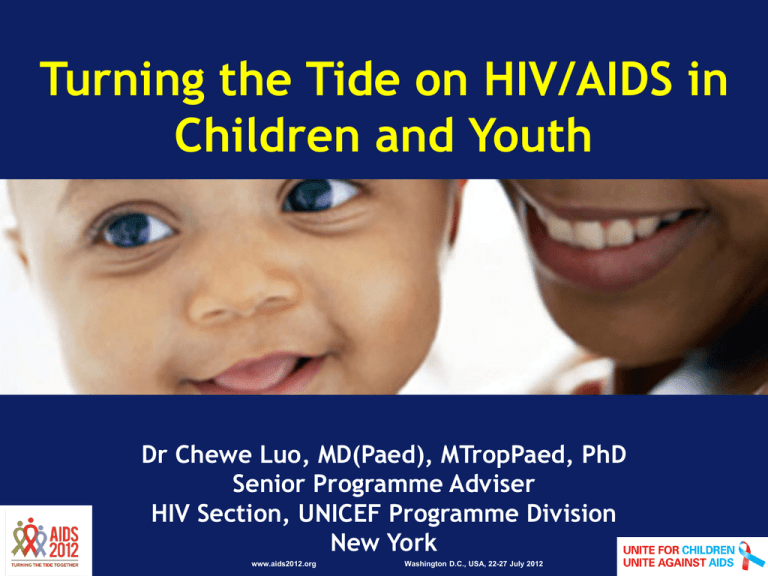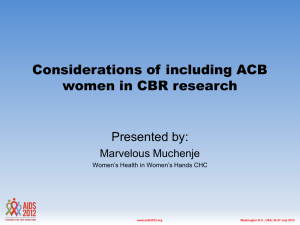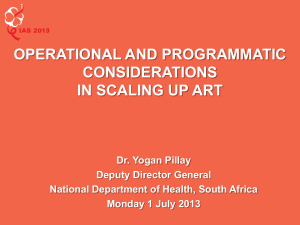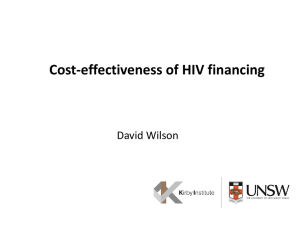Outline - Aids 2012
advertisement

Turning the Tide on HIV/AIDS in Children and Youth Dr Chewe Luo, MD(Paed), MTropPaed, PhD Senior Programme Adviser HIV Section, UNICEF Programme Division New York www.aids2012.org Washington D.C., USA, 22-27 July 2012 Outline What does turning the tide mean? •Eliminating new HIV infections in children •Early diagnosis and treatment of HIV infected children •Adolescent Prevention and Treatment •Call to Action www.aids2012.org Washington D.C., USA, 22-27 July 2012 Key concepts in vertical transmission TRANSMISSION TIMELINE • Transmission can occur during pregnancy, labor & delivery, and postpartum during breast feeding • Not all infants born to women living with HIV will acquire HIV infection – Estimated risk 25-45% without any intervention Source: DeCock et al. JAMA.2000; 283:1175-1182. www.aids2012.org Washington D.C., USA, 22-27 July 2012 67% Reduction in Perinatal Transmission with PACTG 076 AZT Regimen DSMB halted trial early in Feb 1994 Incidence of Perinatally-Acquired AIDS United States, 1985-2000 Source: www.cdc.gov/hiv/perinatal/resources www.aids2012.org Washington D.C., USA, 22-27 July 2012 Overall Target 1: Reduce the Number of New HIV Infections among children by 90% by 2015 Estimated new Pediatric Infections in Low and Middle Income Countries (LMICs) 450,000 Country Contribution to 390,000 Paediatric HIV Infections in LMICs in 2010 430,000 Nigeria 390,000 400,000 10% DRC 350,000 330,000 29% 300,000 13% Malawi 250,000 Kenya 2% 200,000 Mozambique 3% 150,000 India 5% 100,000 7% 43,000 50,000 New Infections 2009 New Infections 2010 New New Infections Infections 2011 2015 (Goal) 6% 6% 6% Zimbabwe Ethiopia Other Priority Countries Other LMICs Source: 1. UNAIDS. Together we will end AIDS. 2012 2 . HIV/AIDS Response – Epidemic Update and Health Sector Progress Towards Universal Access 2011 www.aids2012.org Tanzania 6% 7% 0 Uganda Washington D.C., USA, 22-27 July 2012 Overall Target 2: Reduce the Number of HIVassociated maternal deaths to women during pregnancy, delivery and puerperium by 50% by 2015 Women dying from AIDS-related causes during pregnancy or within 42 days of the end of pregnancy in the 22 priority countries 45,000 42,000 22 priority countries contribution to 33,000 HIV-associated maternal deaths in 2011 1% 1% 40,000 30,000 25,000 21,000 1% .500% 1% .500% 1% 2% 3% 3% 3% 33,000 35,000 1% 20% 5% 20,000 12% 5% 15,000 5% 10,000 9% 5% 5,000 7% 7% 0 2005 2010 2015 (Goal) Source: UNAIDS. Together we will end AIDS. 2012 www.aids2012.org Washington D.C., USA, 22-27 July 2012 7% Nigeria South Africa Tanzania Mozambique Uganda Kenya Malawi India Zimbabwe Zambia DRC Cameroon Cote D'Ivoire Ethiopia Ghana Angola Chad Lesotho Burundi Swaziland Namibia Botswana Prevention of mother-to-child transmission of HIV: Body of scientific research 1994 2010 1994 U.S. AZT Trial ACTG 076 1998 Thai Bangkok short AP/IP AZT trial 1999 PETRA AZT+3TC trial (partly breastfeeding) 1999 Uganda 2-dose IP/PP NVP trial (HIVNET 012) 2000 Thailand PHPT-1 Long vs short AZT regimens 2002 Cote d’Ivoire DITRAME Plus 1201.0 AZT & IP/PP NVP 2003 DITRAME Plus 1201.1 AZT+3TC & IP/PP NVP 2004 Thailand PHPT-2 AZT & IP/PP NVP 2008 PEPI NVP + short vs long AZT for infant (breastfeeding) 2009 Mma Bana comparative trial for CD4<200 (breastfeeding) www.aids2012.org Washington D.C., USA, 22-27 July 2012 Source: McIntyre J, Perinatal HIV Clinical Trials 1998 Cote d‘Ivoire short AP/IP AZT trials (breastfeeding) Coverage of antiretroviral medicine for preventing mother-to-child transmission: most effective regimens, low- and middle-income countries, by region, 2011 90% 80% 79% Percentage (%) 70% 60% 79% 72% 67% 61% 63% 57% 50% 40% 30% 20% 27% 19% 6% 10% 0% Sub-Saharan Eastern and Western and Latin America Latin America Africa Southern Central Africa and the Africa Caribbean Caribbean East, South and SouthEast Asia Source: UNAIDS. Together we will end AIDS 2012 www.aids2012.org Washington D.C., USA, 22-27 July 2012 Eastern Europe and Central Asia North Africa and the Middle East All low- and middleincome countries The decline in new HIV infections in children was roughly 10.8% from 2010 to 2011 Source: 1. UNAIDS 2012 estimates 2. UNICEF/BLC Discussion Paper and Methodology - Business Case for Options B/B+ , 2012 www.aids2012.org Washington D.C., USA, 22-27 July 2012 Global Plan Targets Source: Countdown to zero: Global Plan towards the elimination of new infections among children by 2015 and keeping their mothers alive 2011-2015 www.aids2012.org Washington D.C., USA, 22-27 July 2012 WHO guidelines for PMTCT and infant feeding (2010 and 2012 Update) Source: : 1. WHO 2010 PMTCT Guidelines 2. WHO Programmatic Update 2012 www.aids2012.org Washington D.C., USA, 22-27 July 2012 PMTCT Prophylaxis Options Used by Selected Countries in Africa & Asia, 2012 Option A Option B Option B+ Malawi Cameroon India* Bangladesh Lesotho Zimbabwe Afghanistan DRC Myanmar Bhutan Ethiopia Malaysia Maldives Kenya* Vietnam Nepal Mozambique Swaziland Pakistan South Africa* Tanzania Sri Lanka Uganda* Zambia* Chad Nigeria Angola Burundi Botswana Namibia* Cote D’Ivoire Ghana Rwanda * Countries considering switch to option B/B+ Source: www.aidsdatahub.org based on WHO, UNAIDS, & UNICEF (2011). Towards Universal Access Health Sector Response Country Reports 2011 (preliminary data) www.aids2012.org Washington D.C., USA, 22-27 July 2012 Potential Impact and Cost-Effectiveness of Scenarios “A” and “B” of the 2009 PMTCT Guidelines – 15 Focus Countries, 2010 Scenario “2006” (95% CI) Scenario “A” (95% CI) Scenario “B” (95% CI) Infant HIV Infections (thousands) 345 (328-361) 242 (231-252) 258 (247-270) Infections Averted (thousands) 66 (50-82) 169 (159-180) 152 (141-163) Life-Years Gained (LYG millions) 1.3 (0.7-2.0) 3.2 (2.7-3.6) 2.9 (2.4-3.4) Additional LYG (millions) - 1.9 (0.8-2.9) 1.6 (0.4-2.7) Cost (US $ millions) 64 (55-73) 235 (223-247) 343 (325-362) Additional Cost (millions) - 171 (150-192) 288 (252-307) ICER (US $/LYG) - 92 (81-107) Equally Effective More Expensive Model Outcome Source: Auld AF et al. XVIII IAS Conf, Vienna, July 2010 Abs www.aids2012.org Washington D.C., USA, 22-27 July 2012 Bottlenecks in the implementation of Option A Source: UNICEF/BLC Discussion Paper and Methodology - Business Case for Options B/B+ , 2012 www.aids2012.org Washington D.C., USA, 22-27 July 2012 Women Eligible for ART Are At Highest Risk for Mother-to-Child HIV Transmission and Mortality Eligible for ART Not eligible for ART MTCT by 6 wk 16.7% 5.0% Proportion of MTCT by 6 wks 87.5% 12.5% MTCT after 6 wks 17.0% 4.2% Proportion of MTCT after 6 wks 87.5% 12.5% Maternal mortality 24 mo post delivery 92% 8% • Cohort 1,025 pregnant women in Zambia prior to HAART availability • Analyzed MTCT/mortality by eligibility for ART with current WHO criteria (CD4 <350 or WHO Stage 3 or 4) Source: Kuhn L et al. AIDS 2010;24:1374-7 www.aids2012.org Washington D.C., USA, 22-27 July 2012 Mortality risk in HIV-positive postpartum women with high CD4 Data: Hargrove AIDS 2010; Model: Williams JID 2006. www.aids2012.org Washington D.C., USA, 22-27 July 2012 Double Orphaning is projected to increase by 2016… Estimates of double orphans for 2010 and 2016 9.00% 8.00% 7.00% 6.00% 5.00% 4.00% 3.00% 2.00% 1.00% .00% Double orphan prevalence 2010 Double orphan prevalence 2016 Source: Belsey, M. A., L. Sherr. An International Interdisciplinary Journal for Research, Policy and Care; 6 (3):185-200. www.aids2012.org Washington D.C., USA, 22-27 July 2012 Malawi: Proposed “Option B+” Life-Long ART Rationale: • Without CD4, women who need treatment for their own health will not receive appropriate ART with Option A • Obtaining CD4 has been a barrier to PMTCT implementation in countries with heavily constrained health systems • Prolonged breastfeeding up to 2 years • High fertility rates with an average of 5.6 • New potential benefit to uninfected sexual partners Lancet 2011;378:282-4 www.aids2012.org Washington D.C., USA, 22-27 July 2012 Malawi: “Option B+” Scale Up Number of pregnant and breastfeeding women starting ART 40000 35000 New patients starting ART 30000 25000 Breastfeeding women starting ART 20000 15000 Pregnant women starting ART 10000 5000 0 Q4 2011 Q1 Q2 Q3 Q4 Six-fold increase in number of pregnant & breastfeeding women starting ART (from 1200 in Q2 to 15,000 in Q4) Source: Courtesy of Dr Erik Schouten, unpublished data, Malawi www.aids2012.org Washington D.C., USA, 22-27 July 2012 Malawi: Progress on key indicators for the Global Plan for eliminating mother-to-child transmission Malawi: Percent of women provided antiretrovirals to reduce transmission during pregnancy and delivery (excl sdNVP) Malawi: Percent of pregnant women receiving antiretroviral therapy for their own health 60% 60% 50% 50% 40% 40% 30% 30% 51% 53% 20% 20% 10% 24% 10% 12% 0% 0% 2009* 2011 2009 2011 * 2009 value is not directly comparable to data from 2010 and later because single-dose nevirapine was excluded from the calculation starting in 2010. Source: . 2012 UNAIDS estimates for Malawi: ARV/ART coverage among HIV+ pregnant women (Progress in 22 priority countries on key indicators for the Global Plan for eliminating mother-to-child transmission) www.aids2012.org Washington D.C., USA, 22-27 July 2012 Option B+ Benefits Source: UNICEF/BLC Discussion Paper and Methodology - Business Case for Options B/B+ , 2012 www.aids2012.org Washington D.C., USA, 22-27 July 2012 Comprehensive MCH Services www.aids2012.org Washington D.C., USA, 22-27 July 2012 Acute Infection in Mothers Associated with MTCT • Risk of MTCT in infants of mothers with acute infection during pregnancy or lactation is increased ~3-fold over mothers with chronic HIV. Acute/recent HIV infection Author Population Moodley D (JID 2011; 203:1231-4) 1,396 HIVwomen/48 Taha TE (AIDS 2011 May 21 epub) 2,561 HIV+ women (PP) 2.9% had recent infection Humphrey (BMJ 2010;341: c6580) 11,240 HIV- women 3.0% seroconverted postpartum 3.4% seroconverted pregnancy or by 12 mo PP HIV Transmission to Infant • 2.3-fold higher risk of MTCT (Overall MTCT 20.5% acute vs 9.0% chronic HIV) • 2.5-fold higher risk in utero MTCT (In utero MTCT 17.8% acute vs 6.7% chronic HIV) www.aids2012.org • 2.8-fold higher risk postnatal MTCT (Postnatal MTCT 23.6% acute vs 8.5% chronic HIV) Washington D.C., USA, 22-27 July 2012 Unmet Need for Family Planning Unmet need for family planning by HIV serostatus based on data from Demographic and Health Surveys in six countries Unmet need among women living with HIV Unmet need among HIVnegative women Change in unmet need over time among all women 21% 21% 25% (2003) to 26% (2008) 16% 18% 31% (2004) to 23% (2009) Malawi 2010 18% 21% 28% (2004) to 26% (2010) Swaziland 2007 12% 14% No comparison available Zambia 2007* 14% 20% 27% (2002) to 27% (2007) Zimbabwe 2006 14% 8% 13% (1999) to 12% (2006) Country and year of survey Kenya 2008 Lesotho 2009 Sources: UNAIDS calculations of data from Demographic and Health Surveys (MEASURE DHS: all surveys by country [web site] (25)) and Millennium Development Goals indicators [web site] (36). aThe difference between women living with HIV and HIV-negative women is statistically significant. Millenium Development Goals Indicators ( http://mdgs.un.org/unsd/mdg/data.aspx) www.aids2012.org Washington D.C., USA, 22-27 July 2012 Percentage of children living with HIV receiving antiretroviral therapy in low- and middleincome countries, 2005, 2009, 2010, and 2011 2005 2009 2010 2011 % of children younger than 15 years living with HIV receiving antiretroviral therapy 70% 65% 61% 60% 56% 55% 50% 46% 42% 42% 40% 39% 40% 34% 30% 21% 20% 32% 31% 28% 26% 23% 17% 20% 10% 6% 5% 23% 21% 12% 10% 9% 6% 4% 0% 1% 5% 6% 0% Sub-Saharan Africa Eastern and Western and Southern Africa Central Africa Latin America and the Caribbean Latin America Caribbean East, South and South-East Asia Source: WHO, UNAIDS and UNICEF. Global HIV/AIDS Response: Epidemic Update and Health Sector Progress Towards Universal Access Progress Report 2011 www.aids2012.org Washington D.C., USA, 22-27 July 2012 Europe and Central Asia North Africa and Total low- and the Middle East middle-income countries Children Initiating Treatment Immediately have better chance of survival Violari et al.NEJM 2008 www.aids2012.org Washington D.C., USA, 22-27 July 2012 Trends in pediatric age distribution at ART initiation (2005-2010) Source: McNairy M. et al. Retention of HIV+ Children on ART in ICAP-supported HIV Care and Treatment Programs. Paper # 959, 19th CROI, Seattle, USA 2012 www.aids2012.org Washington D.C., USA, 22-27 July 2012 Follow up of infants testing positive via EID at Review Sites Source: UNICEF. EID Review Country Reports 2009 www.aids2012.org Washington D.C., USA, 22-27 July 2012 Viral Load and EID Product Pipeline Source: UNITAID HIV/AIDS Diagnostic Landscape 2nd Edition 2012 www.aids2012.org Washington D.C., USA, 22-27 July 2012 Paediatric Antiretrovirals: simplified dosing formats and analysing their adverse events CHAPAS-1 trial PK sub-study 2007 FDA licensing CHAPAS-2 LPV/r liquid vs tablets vs sprinkles PK study 3TC/ZDV/N VP Baby CHAPAS-3 Looking at specific toxicities in children d4T vs AZT vs ABC 3TC/ABC Baby and Junior Efavirenz 600mg 2 x 300mg 3 x 200mg Source: Dr Gibb for the Chapas Trials www.aids2012.org Washington D.C., USA, 22-27 July 2012 In 2011, 36% of new HIV infections worldwide occurred in young people (ages 15-24) Source: UNAIDS., updated 2012 estimates. www.aids2012.org Washington D.C., USA, 22-27 July 2012 Increasing HIV Prevalence in Adolescents South Africa: HIV Prevalence Among Adolescents and Young People 20 25 20 15 Prevalence Prevalence Mozambique: HIV Prevalence Among Adolescents and Young People 15 10 10 5 5 0 0 2-14 Male Prev 15-19 Age 20-24 Female Prev 12-14 Male Prev 15-19 Age 20-24 Female Prev Source: 1. National Institute of Health (INS), National Institute of Statistics (INE) and ICF Macro. 2010. National Enquiry on HIV/AIDS Prevalence, Behavior Risks and Information in Mozambique 2009. 2 . Shisana O et al. South African national HIV prevalence, incidence, behaviour and communication survey 2008: A turning tide among teenagers? www.aids2012.org Washington D.C., USA, 22-27 July 2012 Prevention and Treatment Interventions for Adolescents DECREASING VULNERABILITY 1. Enrollment and retention of girls in School 2. Skill-based health education 3. Decreasing gender-based violence 4. Increasing age of marriage 5. Ensuring that health services respond to the needs of adolescents 6. Social protection 7. Protection, legislation, enforcement Interventions that should be supported whether or not there was and HIV epidemic for rights or equity DECREASING RISK 1. Testing 2. Treatment 3. Harm Reduction I. Condoms II. Needle Exchange 4. Male Circumcision 1. For today: Adolescents 2. For the future: Neonatal Specific evidence-based interventions that decrease the risk of HIV among young people for HIV, rights and equity Source: UNICEF Making the Case for Adolescents, unpublished data , 2012 www.aids2012.org Washington D.C., USA, 22-27 July 2012 Call to Action • • • • • Simplify our programmatic approaches to allow integration of PMTCT/ART in maternal child health services at the lowest levels of care – to optimize treatment access, adherence and retention Introduce innovative approaches to expand provider initiated HIV testing to adolescents, pregnant women and their partners Expand early infant diagnosis and integrate paediatric HIV treatment and care at lower level facilities and child survival programs Collaborate with community groups, including women living with HIV, to enhance support to women and their families to maintain good adherence and retention in care and treatment Focus on how to effectively deliver high impact interventions to adolescent to achieve the best prevention and treatment benefits www.aids2012.org Washington D.C., USA, 22-27 July 2012 Acknowledgments • • • • • • Dr Elaine Abrams Dr Wafaa El-Sadr Dr Diana Gibb Dr Priscilla Idele Dr Susan Kasedde Malawi Ministry of Health www.aids2012.org • • • • • Mr Craig McClure Dr Lynne Mofenson Mr Tyler Porth Dr Juliana Silva UNICEF Regional and Country Advisors • Dr Rachel Yates Washington D.C., USA, 22-27 July 2012 Thanks to all women and children that inspire and guide the work we do!! Thank you!! www.aids2012.org Washington D.C., USA, 22-27 July 2012





